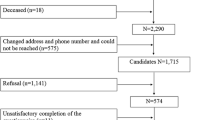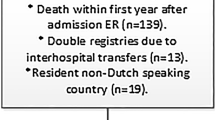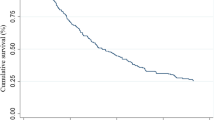Abstract
Purpose
A novel indicator called health-adjusted leave days (HALDs) is proposed. It integrates the opposite level of health-related quality of life (HRQoL) with the sick leave days (LDs) before return-to-work (RTW) to better measure the impact of injuries on occupational health.
Methods
A total of 1,167 limb injuries were consecutively recruited in a teaching hospital from January to December 2009. The number of LDs was calculated between the date of injury and the first episode of RTW. Each subject was repeatedly assessed with EuroQol instrument (EQ-5D) before RTW. The HRQoL index is defined as 1 minus the EQ-5D utility and re-scaled to 0–1 range to reflect the impact of injuries. The expected HALD of each group is calculated by integrating the product of the proportion of non-RTW function and the mean HRQoL index function over the days followed up to 2 years for the group. We compared the expected HALDs between subgroups according to various demographic characteristics and consequences of injury.
Results
Older and female workers tended to have longer LDs than men and younger workers, with an increase in percentage change of 16.0 or 139.5 %, respectively. After adjusting for HRQoL index, the percentages for HALDs were changed to 28.7 or 186.6 %, respectively. The percentages for the less-educated workers and blue collar workers were 185.7 and 155.8 %. The expected HALDs showed statistical significant differences in all subgroup analyses.
Conclusion
We believed that the proposed HALD could better measure the impact of injuries and is potentially useful for the clinical decision and industrial policy-making with respect to the assessment of the importance of limb injury due to a worker’s sick leaves.

Similar content being viewed by others
Abbreviations
- HALDs:
-
Health-adjusted leave days
- HRQoL:
-
Health-related quality of life
- LDs:
-
Leave days
- RTW:
-
Return-to-work
- QOL:
-
Quality of life
- LOS:
-
Length of hospital stay
- EQ-5D:
-
EuroQol instrument
References
Ezzati, M., Lopez, A. D., Rodgers, A., Vander Hoorn, S., & Murray, C. J. (2002). Selected major risk factors and global and regional burden of disease. Lancet, 360(9343), 1347–1360.
Ebel, B. E., Mack, C., Diehr, P., & Rivara, F. P. (2004). Lost working days, productivity, and restraint use among occupants of motor vehicles that crashed in the United States. Injury Prevention, 10(5), 314–319.
Liu, Y. H., Lin, M. R., & Wang, J. D. (1995). Cost and determinants of morbidity from work related disabling injuries in Taiwan. Occupational and Environmental Medicine, 52(2), 138–142.
Pransky, G. S., Benjamin, K. L., Savageau, J. A., Currivan, D., & Fletcher, K. (2005). Outcomes in work-related injuries: A comparison of older and younger workers. American Journal of Industrial Medicine, 47(2), 104–112.
Lin, S. H., Lee, H. Y., Chang, Y. Y., Jang, Y., & Wang, J. D. (2011). Estimation of life expectancies and loss-of-life expectancies for workers with permanent occupational disabilities of the extremities—a 21-year follow-up study. Scandinavian Journal of Work, Environment & Health, 38(1), 70–77.
Segui-Gomez, M., & MacKenzie, E. J. (2003). Measuring the public health impact of injuries. Epidemiologic Reviews, 25, 3–19.
Polinder, S., van Beeck, E. F., Essink-Bot, M. L., Toet, H., Looman, C. W., Mulder, S., et al. (2007). Functional outcome at 2.5, 5, 9, and 24 months after injury in the Netherlands. The Journal of Trauma, 62(1), 133–141.
MacKenzie, E. J., Shapiro, S., Smith, R. T., Siegel, J. H., Moody, M., & Pitt, A. (1987). Factors influencing return to work following hospitalization for traumatic injury. American Journal of Public Health, 77(3), 329–334.
Soberg, H. L., Roise, O., Bautz-Holter, E., & Finset, A. (2011). Returning to work after severe multiple injuries: Multidimensional functioning and the trajectory from injury to work at 5 years. The Journal of Trauma, 71(2), 425–434.
Soberg, H. L., Finset, A., Bautz-Holter, E., Sandvik, L., & Roise, O. (2007). Return to work after severe multiple injuries: A multidimensional approach on status 1 and 2 years postinjury. The Journal of Trauma, 62(2), 471–481.
MacKenzie, E. J., Morris, J. A., Jr, Jurkovich, G. J., Yasui, Y., Cushing, B. M., Burgess, A. R., et al. (1998). Return to work following injury: The role of economic, social, and job-related factors. American Journal of Public Health, 88(11), 1630–1637.
Hou, W. H., Tsauo, J. Y., Lin, C. H., Liang, H. W., & Du, C. L. (2008). Worker’s compensation and return-to-work following orthopaedic injury to extremities. Journal of Rehabilitation Medicine, 40(6), 440–445.
MacKenzie, E. J., Bosse, M. J., Kellam, J. F., Pollak, A. N., Webb, L. X., Swiontkowski, M. F., et al. (2006). Early predictors of long-term work disability after major limb trauma. The Journal of Trauma, 61(3), 688–694.
Garratt, A., Schmidt, L., Mackintosh, A., & Fitzpatrick, R. (2002). Quality of life measurement: Bibliographic study of patient assessed health outcome measures. British Medical Journal, 324(7351), 1417.
Chuang, H. Y., Chao, K. Y., & Wang, J. D. (2005). Estimation of burden of lead for offspring of female lead workers: A quality-adjusted life year (QALY) assessment. Journal of Toxicology and Environmental Health, Part A, 68(17–18), 1485–1496.
Lee, H. Y., Hwang, J. S., Jeng, J. S., & Wang, J. D. (2010). Quality-adjusted life expectancy (QALE) and loss of QALE for patients with ischemic stroke and intracerebral hemorrhage: A 13-year follow-up. Stroke, 41(4), 739–744.
Hsu, C., Wang, J. D., Hwang, J. S., Tien, H. F., Chang, S. M., Cheng, A. L., et al. (2003). Survival-weighted health profile for long-term survivors of acute myelogenous leukemia. Quality of Life Research, 12(5), 503–517.
Lee, H. Y., Chen, Y. H., Chiu, W. T., Hwang, J. S., & Wang, J. D. (2010). Quality-adjusted life-years and helmet use among motorcyclists sustaining head injuries. American Journal of Epidemiology, 100(1), 165–170.
Hou, W. H., Sheu, C. F., Liang, H. W., Hsieh, C. L., Lee, Y., Chuang, H. Y., et al. (2012). Trajectories and predictors of return to work after traumatic limb injury—a 2-year follow-up study. Scandinavian Journal of Work, Environment & Health, 38(5), 456–466.
Hou, W. H., Liang, H. W., Sheu, C. F., Hsieh, C. L., & Chuang, H. Y. (2012). Return to work and quality-of-life in workers with traumatic limb injuries: A 2-year repeated measurements study. Archives of physical and Medical Rehabilitation. doi:10.1016/j.jacr.2012.08.005.
Chang, T. J., Tarn, Y. H., Hsieh, C. L., Liou, W. S., Shaw, J. W., & Chiou, X. G. (2007). Taiwanese version of the EQ-5D: Validation in a representative sample of the Taiwanese population. Journal of the Formosan Medical Association, 106(12), 1023–1031.
The EuroQol Group. (1990). EuroQol–a new facility for the measurement of health-related quality of life. Health Policy, 16(3), 199–208.
Burstrom, K., Johannesson, M., & Diderichsen, F. (2001). Swedish population health-related quality of life results using the EQ-5D. Quality of Life Research, 10(7), 621–635.
Johnson, J. A., Luo, N., Shaw, J. W., Kind, P., & Coons, S. J. (2005). Valuations of EQ-5D health states: Are the United States and United Kingdom different? Medical Care, 43(3), 221–228.
Dolan, P. (1997). Modeling valuations for EuroQol health states. Medical Care, 35(11), 1095–1108.
Derrett, S., Black, J., & Herbison, G. P. (2009). Outcome after injury-a systematic literature search of studies using the EQ-5D. The Journal of Trauma, 67(4), 883–890.
Hwang, J. S., & Wang, J. D. (2004). Integrating health profile with survival for quality of life assessment. Quality of Life Research, 13(1), 1–10 (discussion 11–14).
Hwang, J. S., & Wang, J. D. (1999). Monte Carlo estimation of extrapolation of quality-adjusted survival for follow-up studies. Statistics in Medicine, 18(13), 1627–1640.
Lin, S. H., Lee, H. Y., Chang, Y. Y., Jang, Y., & Wang, J. D. (2012). Estimation of life expectancies and loss-of-life expectancies for workers with permanent occupational disabilities of the extremities–a 21-year follow-up study. Scandinavian Journal of Work, Environment & Health, 38(1), 70–77.
Rosser, R. M., & Watts, V. C. (1972). The measurement of hospital output. International Journal of Epidemiology, 1(4), 361–368.
Lopez, A. D., & Mathers, C. D. (2006). Measuring the global burden of disease and epidemiological transitions: 2002–2030. Annals of Tropical Medicine and Parasitology, 100(5–6), 481–499.
Chu, P. C., Wang, J. D., Hwang, J. S., & Chang, Y. Y. (2008). Estimation of life expectancy and the expected years of life lost in patients with major cancers: Extrapolation of survival curves under high-censored rates. Value in Health, 11(7), 1102–1109.
Ho, J. J., Hwang, J. S., & Wang, J. D. (2006). Life-expectancy estimations and the determinants of survival after 15 years of follow-up for 81 249 workers with permanent occupational disabilities. Scandinavian Journal of Work, Environment & Health, 32(2), 91–98.
Ho, J. J., Hwang, J. S., & Wang, J. D. (2006). Estimation of reduced life expectancy from serious occupational injuries in Taiwan. Accident Analysis and Prevention, 38(5), 961–968.
Lin, S. H., Lee, H. Y., Chang, Y. Y., Jang, Y., Chen, P. C., & Wang, J. D. (2010). Increased mortality risk for workers with a compensated, permanent occupational disability of the upper or lower extremities: A 21-year follow-up study. American Journal of Epidemiology, 171(8), 917–923.
Acknowledgments
The authors would like to thank Chen-Long Wu for expert opinion, Tsuey-Hwa Hu for statistical assist, and Pei-Shan Li for document collection. This study was supported by research grants from the National Science Council (NSC 99-2314-B-650-001-MY2 and NSC 101-2314-B-038-055-) and the E-Da Hospital (EDAHP-99001 and EDAHP-101002).
Author information
Authors and Affiliations
Corresponding author
Additional information
Jing-Shiang Hwang and Hung-Yi Chuang contributed equally to this work.
Rights and permissions
About this article
Cite this article
Hou, WH., Liang, HW., Hsieh, CL. et al. Integrating health-related quality of life with sickness leave days for return-to-work assessment in traumatic limb injuries. Qual Life Res 22, 2307–2314 (2013). https://doi.org/10.1007/s11136-013-0364-2
Accepted:
Published:
Issue Date:
DOI: https://doi.org/10.1007/s11136-013-0364-2




